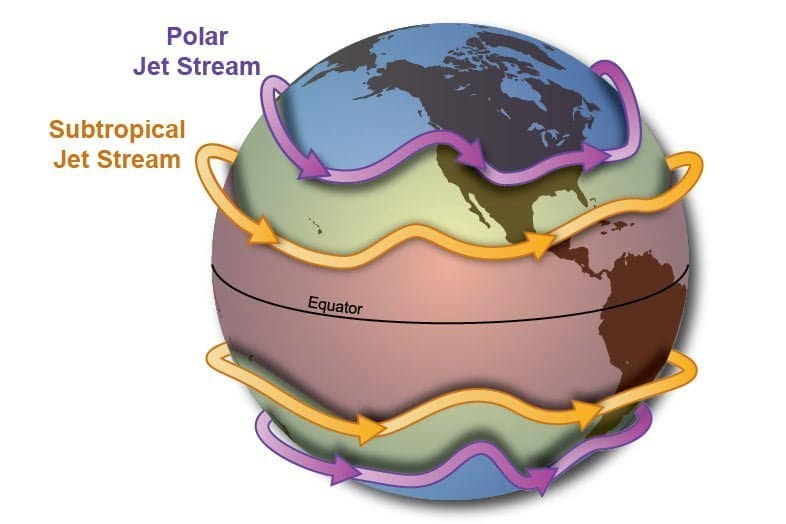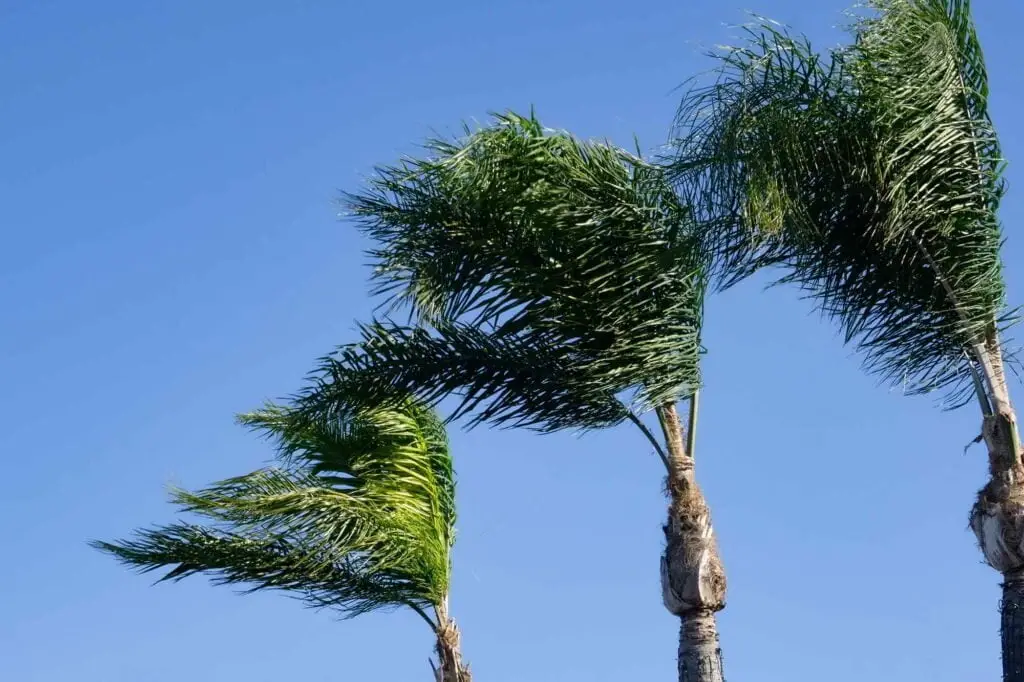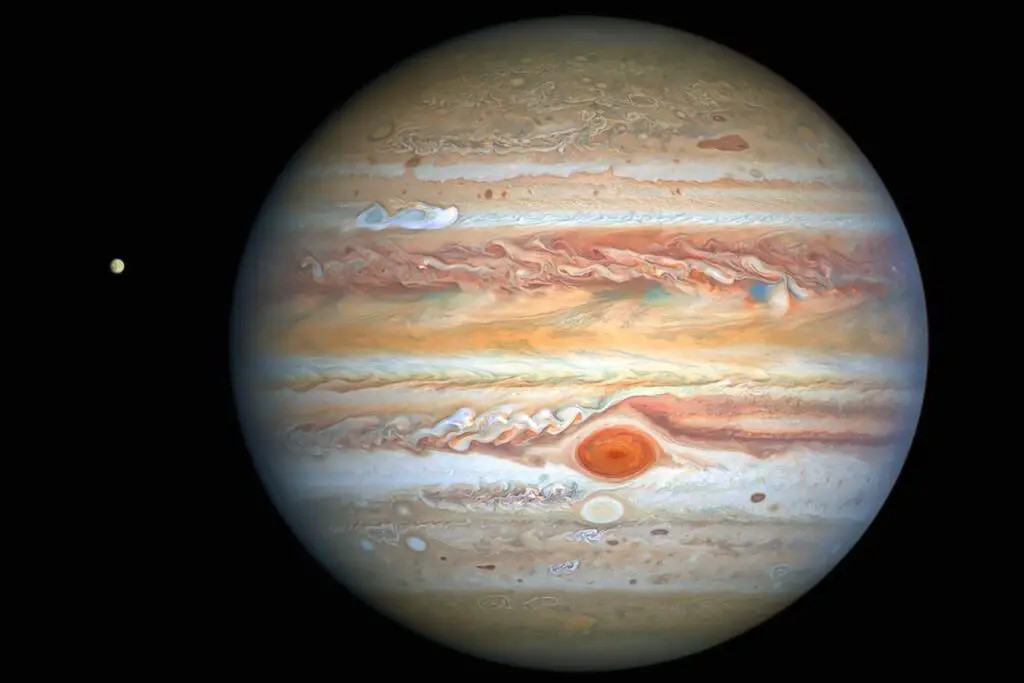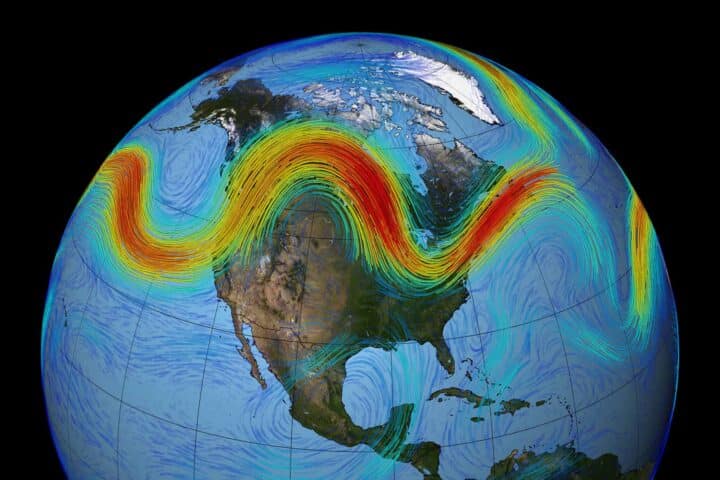Jetströmmen är ett smalt band av starka vindar i de övre delarna av jordens atmosfär, och den blåser från väst till öst och utgör en korridor som stormar kan följa när de cirkulerar runt jorden. Jetströmmar bildas längs gränserna mellan varm och kall luft, och jetströmmens vickningar spelar en stor roll för det väder du upplever.
I allmänhet är jetströmmarna starkast under vintermånaderna eftersom temperaturskillnaderna mellan de varma och kalla luftmassorna är störst vid denna tidpunkt.
Vindarna i de övre delarna av atmosfären längs jetströmmen kan vara så snabba som 200mph och ibland högre, vilket ger impulsen att driva vädersystem längs och framför den. Jetströmvindar finns på ca 30 000 fot i luften, samma höjd som flygplan flyger på. Piloter använder jetströmmen för att spara bränsle på resor mellan väst och öst, även om det kan orsaka kraftig turbulens att passera genom särskilt starka delar av jetströmmen, så kallade jetstrimmor, vinkelrätt mot varandra.
Om du någonsin har undrat varför en flygresa från öst till väst tar längre tid än returresan, så är det därför. På resan västerut måste planet kämpa med vindar som blåser mot flygplanet och saktar ner det. På väg österut blåser vinden däremot mot flygplanets baksida, vilket gör att flygplanet kan flyga mycket snabbare på återresan.
Detta förklarar också varför en pilot kanske inte flyger en helt rak rutt från väst till öst. Piloten passerar genom en svagare del av jetströmmen för att minska turbulensen. om möjligt

Hur jetströmmen påverkar vårt väder
Det finns två huvudsakliga jetströmmar i vår atmosfär, den polära och den subtropiska jetströmmen. Den subtropiska jetströmmen drar sig tillbaka till tropikerna på vintern och rör sig norrut till de mellersta breddgraderna under sommaren. Den polära jetströmmen, å andra sidan, håller sig närmare polerna under större delen av året men blir starkare under vintermånaderna och dyker söderut till de norra mellanbredderna under vintern, ibland till de subtropiska breddgraderna under särskilt stränga köldperioder.
En sydlig nedgång i den polära jetströmmen kan också bidra till att förflytta polarvirvel från sin vanliga position över 60 breddgrader (detta är inte den enda anledningen till att den beter sig som den gör, som vi diskuterar här).
När jetströmmen utvecklar en nordlig puckel över land, en så kallad ås, får de som befinner sig inom åsen torrt och varmare väder. Omvänt signalerar en sydlig sänka, ett så kallat tråg, svalare och torrare väder, även om det i närheten av jetströmmen kan bildas stormar och nederbörd. Fronter bildas längs jetströmmen och rör sig med den, och lågtryck följer vanligtvis jetströmmen eller ligger nära dess bana.

Jetströmmar på låg nivå
Medan den polära och subtropiska jetströmmen är ansvarig för vårt varierande väder, kan andra typer av jetströmmar då och då bildas närmare ytan. Dessa kallas ofta för "jetströmmar på låg nivå".
Under sommaren, åskväder utvecklas ofta i kallfronternas nedåtgående luftströmmar. Denna downdraft skapar en jetström i mikroskala som leder luften mot marken, där den kan bidra till att starta åskväder.
En annan typ av lågnivåjet kallas för ett förhöjt blandat skikt. Under denna händelse är vindarna vid ytan relativt lugna, men en jetström utvecklas på hög höjd och blåser ner till ytan. Höga blandade skikt bildas vanligtvis över bergskedjor när luften sjunker ned på andra sidan bergen, vilket skapar ett högt lågtrycksområde som hjälper till att dra vindar från höjden till marken.
Den ökända Santa Ana-vindar är också en biprodukt av en jetström på låg nivå. Under dagen skapar Santa Ana-vindarna en jetström på låg nivå längs Kaliforniens kust och södra Nevada, vilket bidrar till att värma upp och torka ut luften innan stormar närmar sig.
På natten kollapsar denna jetström och vindar blåser från inlandet mot kusten, ibland med en styrka på orkan kraft. Om de inträffar under säsongen för skogsbränder kan de på några timmar förvandla en liten skogsbrand till en flera tusen hektar stor eldsvåda.
Vintercyklonerna vid Great Lakes är ett annat exempel på en jetström på låg nivå. Lågtryckssystemet bildades över de stora sjöarna, i kombination med kalla vindar från Kanada och norrut, tryck en horisontell jetström söderut in i närliggande stater. Under dessa händelser uppstår starka vindar nära Lake Michigan och Lake Huron när varmare luft blir instängd över det kallare vattnet i sjöarna.

Jetströmmar är inte bara ett jordiskt koncept
Jetströmmar förknippas oftast med jordens atmosfär, men de finns även på andra planeter. Astronomer har observerat flera jetströmmar på Jupiters yta, som är synliga tack vare den färgglada moln av planetens atmosfär.
Även andra planeter har jetströmmar: Saturnus har en "subtropisk ås", och Uranus har en "atmosfärisk krage" av vindar som cirkulerar runt dess nord- och sydpol. Även om vi inte har haft möjlighet att direkt observera atmosfären hos de tusentals planeter som upptäckts under de senaste decennierna, har många av dessa exoplaneter sannolikt liknande atmosfäriska fenomen som de jetströmmar vi ser här på jorden.



